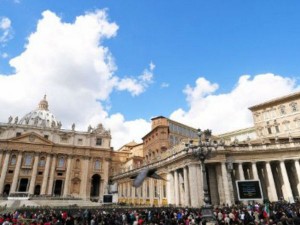VATICAN CITY—The Vatican on Saturday installed a special chimney on the Sistine Chapel from which white smoke will signal the election of a new pope as cardinals prepare for the historic vote next week after Benedict XVI’s resignation.
The conclave of 115 “cardinal electors” will begin on Tuesday under Michelangelo’s famous frescoes to choose the 266th pope following the abrupt end to Benedict’s eight-year papacy which was often overshadowed by scandals.
French cardinal Andre Vingt-Trois, the Archbishop of Paris, told Agence France-Presse in an interview that there were around “half a dozen possible candidates.”
Italian cardinal Angelo Scola, the Archbishop of Milan, is seen as one favorite, along with Canada’s Marc Ouellet and Brazil’s Odilo Scherer.
Other names mentioned on the rumor mill in recent days have been Hungary’s Peter Erdo, Mexico’s Jose Francisco Robles Ortega, Austria’s Christoph Schoenborn and Sri Lanka’s Albert Malcolm Ranjith.
“The problem with this conclave is that there is no early frontrunner like Joseph Ratzinger in 2005,” said John Allen, a Vatican expert at the National Catholic Reporter, a US weekly.
Luis Antonio Tagle, the Archbishop of Manila, a youthful and popular cardinal, has also been mentioned as a possible candidate.
“If there was a direct election among the 1.2 billion Catholics in the world he would win by a landslide but that is not how the Church works,” Allen said.
The decision on the date of the conclave was taken on Friday at one of a series of closed-door meetings held by cardinals over the past week to discuss the many challenges facing the next pope.
Cardinals, with no new pope to defer to and no late pope to grieve over, have seized on the rare chance to air grievances against the Vatican administration and call for greater transparency.
The 85-year-old Benedict last month admitted he was too weak in body and mind to keep up with the modern world and became only the second head of the Roman Catholic Church ever to resign by choice in its 2,000-year history.
“Pope emeritus” Benedict has stayed out of pre-conclave debates and is living at the papal summer residence of Castel Gandolfo near Rome for the next couple of months, after which he will move to a former convent inside the Vatican.
Conclave lockdown
Vatican workers meanwhile have put the final touches on preparations for the Sistine Chapel, blacking out windows to prevent any spying on the conclave and installing scrambling devices to prevent any communication with the outside world.
Under the rules of this centuries-old tradition, cardinals have to swear a solemn oath not to reveal any details of their deliberations on pain of excommunication and the Sistine Chapel will be swept for recording devices.
No-one except the “cardinal electors” — cardinals below the threshold age of 80 — can be present during the two daily rounds of voting, which will kick off with a first vote late on Tuesday.
A two-thirds majority is required.
The Renaissance jewel takes its name from pope Sixtus IV, who had it built between 1477 and 1480. Situated next to St. Peter’s Basilica, it has the same dimensions as the first Holy Temple built in Jerusalem by King Solomon.
One of the most visited sites in the world, with up to 20,000 tourists a day, the Sistine Chapel features one of art history’s most famous scenes, depicting God stretching out his arm to touch Adam’s hand and give him life.
The chapel is now off limits to visitors and the Floreria, the Vatican department in charge of preparing for papal audiences and ceremonies, has been outfitting it for the conclave with a raised platform and tables.
Twelve long tables will be laid out in four rows, two on either side of the chapel, covered with runners in beige with bordeaux satin skirting.
The cardinals — traditionally known as “Princes of the Church” — will sit on cherry-wood chairs to fill in their ballot papers in the papal election.
Folded votes will first be placed on a bronze plate, known as a paten, and then slid into an urn shaped like a flying saucer, decorated with two lambs, signifying the flock of God’s faithful who will be led by the future pope.
On the left of the entrance to the chapel, two stoves with one common flue have been installed for the burning of the votes once they have been counted.
Ballots will be burnt in one of the stoves, engraved with the names of the last six popes and the dates they were elected. Chemicals burnt in the second stove will ensure the color of the smoke in the sky cannot be misread.
Black smoke will mean no decision has yet been made, white smoke signals a pope has been chosen. There are two daily rounds of voting and the pope is elected by a two-thirds majority and a simple acceptance of the vote.
The beginning of the conclave will be preceded by a special mass on Tuesday in St Peter’s Basilica called “Pro Eligendo Romano Pontifice” (“For the Election of the Roman Pontiff”).
On the eve of the conclave, cardinals on Monday will move into Casa Santa Marta (St Martha’s House), a residence inside the Vatican walls where they will eat and sleep between rounds of voting.
There too the strict rules of conclave secrecy apply: windows in the residence are locked and the telephones in the rooms are for internal use only.
